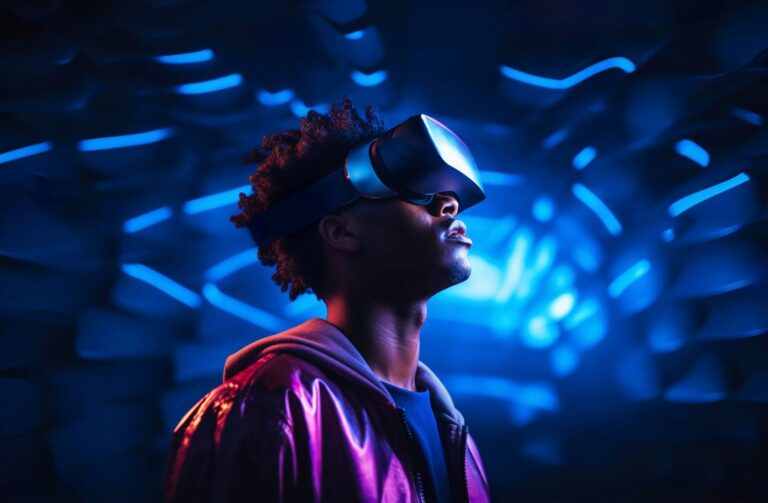Have you ever imagined what it would be like to see digital information seamlessly integrated with the real world? Picture walking down a city street and having the names and ratings of nearby restaurants appear right before your eyes or playing a game where virtual characters come to life in your own living room. This is the fascinating world of augmented reality (AR).
Definition of Augmented reality
Augmented Reality is a fascinating technology that overlays digital information, like images or sounds, onto the real world. Unlike Virtual Reality, which immerses you in a completely digital environment, AR enhances your current reality with interactive elements. Think of it as a way to make your everyday experiences more exciting and engaging.
But why should you care about AR? Well, it’s not just for tech enthusiasts or gamers. AR is quickly becoming a part of our daily lives, from the apps we use on our phones to innovative tools in education, healthcare, and beyond.
So, how does this all work, and where is it headed? Let’s go into the world of Augmented Reality and explore how it’s transforming the way we see and interact with the world around us.
How Does Augmented reality It Works
Augmented Reality (AR) is a technology that brings the digital world into your real-life environment. Unlike Virtual Reality, which takes you into a completely virtual space, AR enhances the world you see by adding digital elements to it. Imagine looking at your living room through your phone’s camera and seeing a digital character dancing on your coffee table. That’s AR in action.
AR uses your device’s camera to capture what’s around you in real-time. Then, it processes that information through Artificial Intelligence (AI), which understands the shapes, surfaces, and angles in your environment. By leveraging Machine Learning algorithms, AR continuously improves its understanding of your surroundings. Additionally, Natural Language Processing (NLP) can be used to interpret and respond to voice commands, making the AR experience more interactive and intuitive. Once it has a good grasp of your surroundings, AR adds digital elements—like images, animations, or even sounds—on top of the real-world view you’re seeing.
But how does your device know where to place these digital elements? It’s all about sensors, data, and AI-driven analysis. Your phone or AR headset is packed with sensors that track your movements and the position of objects around you. Machine Learning models analyze this data to predict and adjust the placement of digital content. By constantly updating this information, AR ensures that the digital content stays in the right spot, even if you move around.
For example, when you use an AR app to visualize how a new couch would look in your living room, the app uses your camera to scan the room. AI and Machine Learning algorithms process the scan to understand your room’s layout. Then, it overlays a 3D model of the couch into the exact spot where you want it, making it look like it’s really there.
Sounds pretty cool, right? But this is just the beginning. AR technology is rapidly evolving, with improvements that make these experiences smoother and more immersive. So, the next time you see something that blends the digital with the real, you’ll know just how it’s working behind the scenes. Ready to see where AR is making a big impact? Let’s go into its exciting applications next.
Applications of Augmented Reality
So, where does Augmented Reality (AR) fit into our everyday lives? You might be surprised at how often you’ve already encountered it. AR isn’t just a futuristic idea; it’s being used in ways that are practical, fun, and even life-changing.
Entertainment and Gaming
Let’s start with something many of us are familiar with—gaming. Remember the global craze of Pokémon GO? That’s AR in action. By using your phone, you could see and catch virtual Pokémon in the real world, blending the game with your surroundings. But AR isn’t just about games. It’s also enhancing entertainment experiences like live sports events, where you can see real-time stats and player information right on your screen as you watch the game.
Education
Imagine learning about the solar system not just from a textbook but by seeing planets orbit around your living room. AR makes education interactive and engaging, allowing students to visualize complex concepts in a simple and fun way. It’s like bringing the classroom to life, whether you’re studying history, science, or even art.
Retail and Shopping
Shopping has also gotten a high-tech upgrade with AR. Ever wondered how a new pair of shoes or a piece of furniture would look before buying it? With AR, you can virtually try on products or place items in your home to see how they fit. This makes shopping more convenient and helps you make better decisions without leaving your house.
Healthcare
In healthcare, AR is becoming a powerful tool for training and patient care. For example, medical students can practice surgeries in a controlled, virtual environment that simulates real-life scenarios. Surgeons are also using AR to get real-time data during operations, making procedures safer and more precise.
Benefits of Augmented Reality
Augmented Reality (AR) offers real advantages across various industries. Here’s a quick look at why AR is more than just a cool tech:
- Enhanced User Experience: AR makes everyday activities like gaming, shopping, and learning more engaging by adding interactive digital elements to the real world.
- Improved Learning and Training: AR provides hands-on, visual learning experiences, making education and training more effective and helping people build skills faster.
- Efficiency and Accuracy: In fields like manufacturing and healthcare, AR boosts efficiency by providing real-time instructions and data, reducing errors, and improving outcomes.
- Customer Engagement: AR allows customers to try products before they buy, creating personalized shopping experiences that can lead to higher satisfaction and loyalty.
- Accessibility and Convenience: AR simplifies complex tasks by providing visual guides and overlays, making information easier to access and understand.
Types of Augmented Reality
Augmented Reality (AR) can be broadly categorized into four main types, each with its unique characteristics and applications:
- Marker-Based AR (Image Recognition)
- Markerless AR (Location-Based AR)
- Projection-Based AR
- Superimposition-Based AR
Marker-Based AR
Marker-Based AR, also known as Image Recognition AR, operates using specific visual markers like QR codes or distinct images to trigger digital content. When a device’s camera recognizes these markers, it overlays information, such as 3D models or animations, onto the real world. For instance, a company might use Marker-Based AR in its marketing campaigns, allowing users to scan a product’s packaging with their smartphones to view interactive content, such as assembly instructions or promotional videos. This application is particularly popular in educational tools, where scanning an image in a textbook can reveal additional information or animations, enhancing the learning experience.
Markerless AR
Unlike Marker-Based AR, Markerless AR—often referred to as Location-Based or Position-Based AR—does not rely on predefined visual markers. Instead, it uses the device’s GPS, compass, and accelerometer to determine the user’s location and orientation, overlaying digital content accordingly. A well-known example of Markerless AR is the mobile game Pokémon GO. In this game, players interact with virtual creatures that appear in real-world environments based on their geographic location. This type of AR is also widely used in outdoor navigation and tourism, providing users with real-time information and experiences tailored to their surroundings.
Projection-Based AR
Projection-Based AR functions by projecting digital light onto real-world surfaces, eliminating the need for a screen or handheld device. The digital content is displayed directly onto physical objects, creating an interactive experience. For example, in an art installation, Projection-Based AR might be used to project moving images onto sculptures, allowing viewers to see them in a new light—literally. This type of AR is also used in interactive displays at museums or trade shows, where users can engage with projected content by touching or moving within the projected area.
Superimposition-Based AR
Superimposition-Based AR enhances or replaces parts of the real world with digital elements, providing a more detailed or altered view of reality. In healthcare, for instance, this technology can be invaluable. A surgeon might use AR glasses to superimpose an X-ray image over a patient’s body during surgery, offering a clear view of underlying structures without needing to glance away at separate screens. This type of AR is crucial in fields like architecture, where it allows professionals to visualize and adjust designs in real time, seeing how changes would affect the existing environment.
AR vs. VR
Augmented Reality (AR)
AR, on the other hand, adds digital elements to your real world. Using devices like smartphones or AR glasses, AR overlays information, images, or animations onto your view of the real world. It enhances your reality without replacing it, making it more accessible for everyday use.
Virtual Reality (VR)
VR completely immerses you in a digital world. When you wear a VR headset, you’re transported to a new environment, whether it’s a game, a virtual tour, or a simulated experience. VR replaces your real surroundings with a fully virtual one, requiring specialized equipment like headsets.
Challenges and Limitations of AR
While Augmented Reality (AR) offers exciting possibilities, it also faces several challenges:
Technical Challenges
AR requires powerful hardware and sophisticated software to function smoothly, but these can be expensive and lead to issues like battery drain or glitches that disrupt the experience.
Privacy Concerns
AR apps often need access to personal data like your camera and location, raising concerns about data use and security. There’s also the potential for AR to overlay harmful or misleading content in real-world environments.
Health and Safety Concerns
Prolonged use of AR devices may cause eye strain or discomfort, and there’s a risk of accidents if users become too immersed in the AR experience, losing awareness of their surroundings.
The Future of Augmented Reality
Ever wondered how Augmented Reality (AR) might evolve? The future of AR is exciting and full of potential.
Imagine wearing sleek AR glasses that provide real-time information as you go about your day—directions, reminders, or even interactive games with friends. This could soon be a reality.
In education, AR might let students explore history or science in interactive ways right from their desks. In retail, you could virtually try on clothes or see how new furniture fits in your home before buying. And in healthcare, AR could assist surgeons with 3D models for more precise operations.
As AR technology advances, it promises to make our daily experiences more engaging and immersive. Ready to see how AR will change your world? The future is just around the corner.

